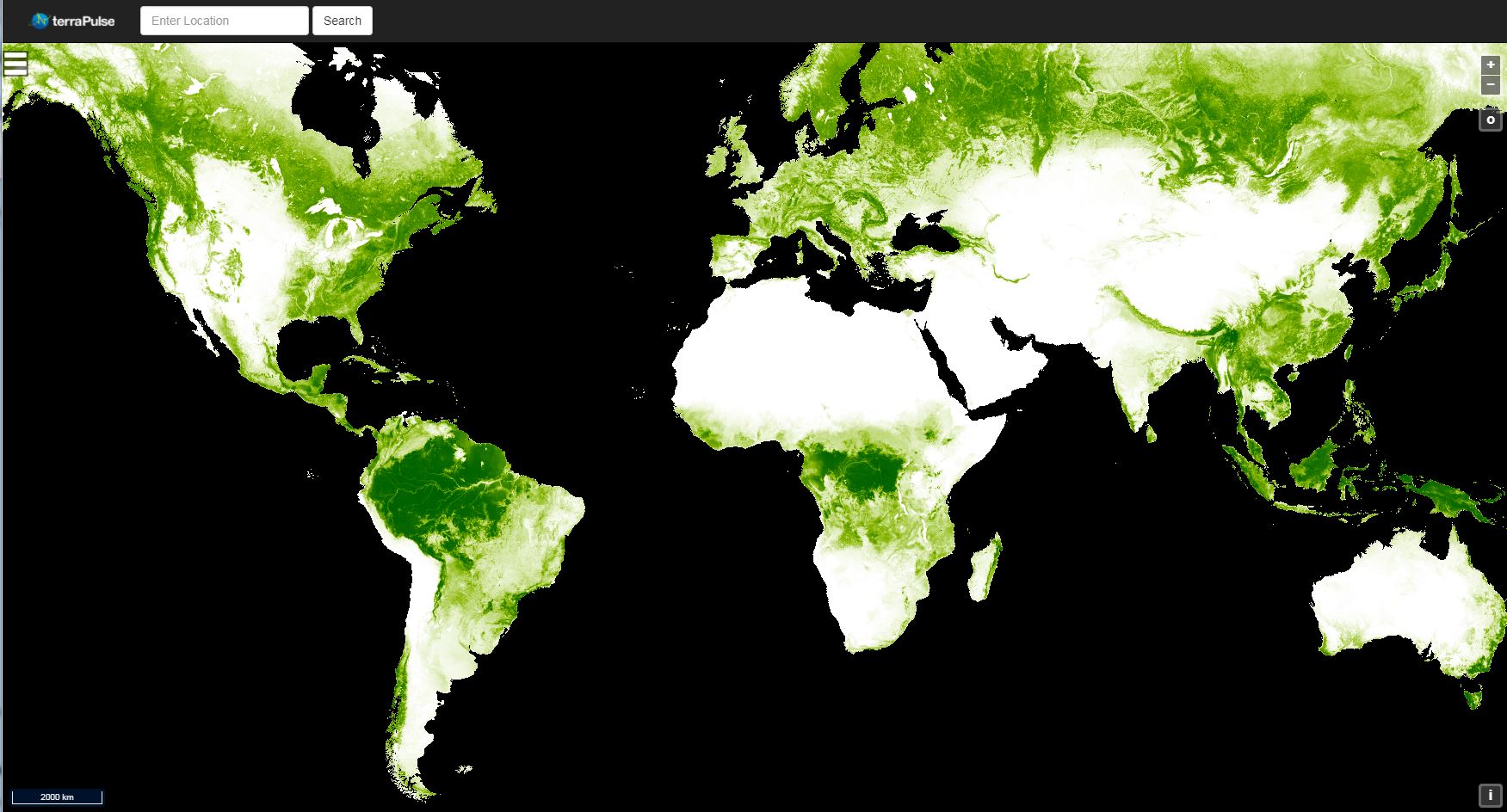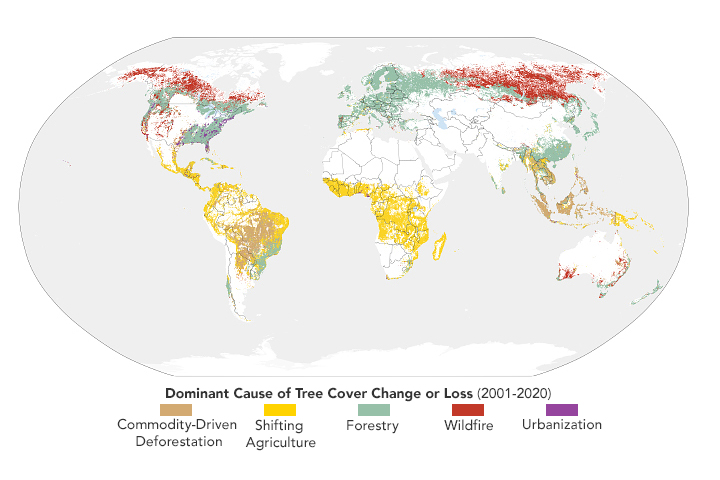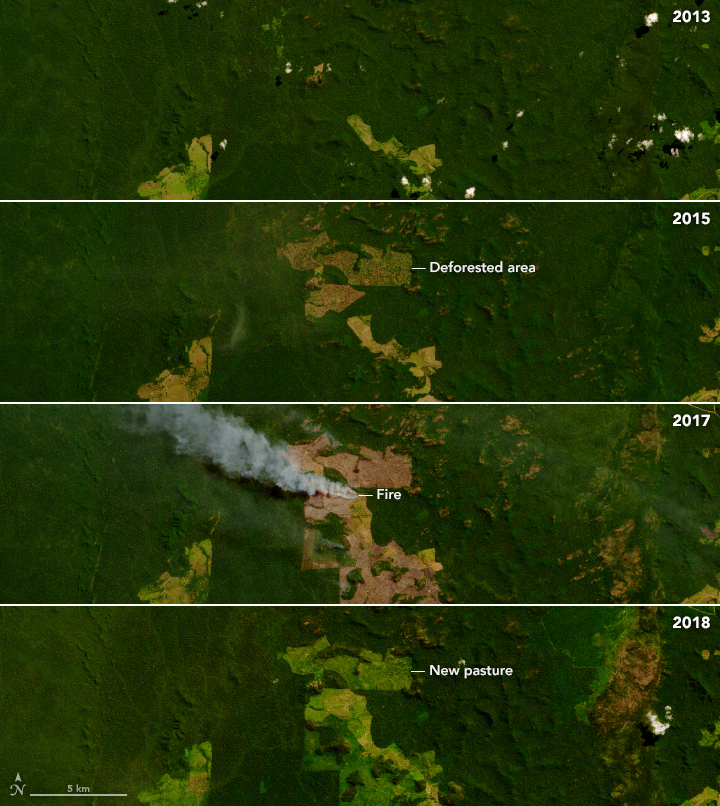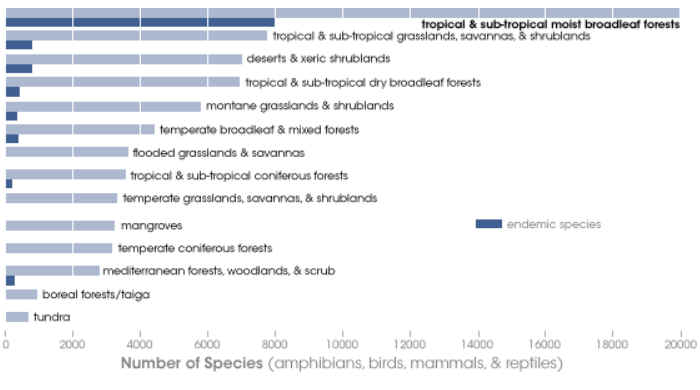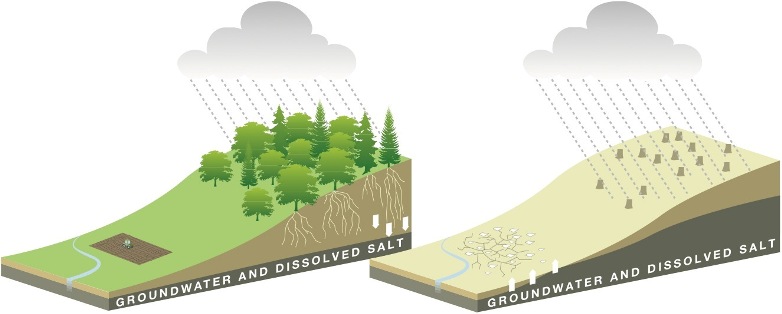
|
||||||||||||
|
|
|
Deforestation
Global 30m Landsat Tree Canopy Version 4 NASA
Deforestation: The conversion of forest to another land use or the long-term reduction of the tree canopy cover below a 10 percent threshold. Deforestation implies the long-term or permanent loss of forest cover and its transformation into another land use.
Using satellite data from the past two decades, scientists are starting to pinpoint which crops and farming styles have lasting impacts on forests-NASA Landstat People have been deforesting the Earth for thousands of years, primarily to clear land for crops or livestock. Direct causes of deforestation are agricultural expansion, wood extraction (e.g., logging or wood harvest for domestic fuel or charcoal), and infrastructure expansion such as road building and urbanization. Rarely is there a single direct cause for deforestation. Most often, multiple processes work simultaneously or sequentially to cause deforestation.
The world’s total forest area is just over 4 billion hectares, corresponding to 31 percent of the total land area or an average of 0.6 ha per capita. The five most forest-rich countries (the Russian Federation, Brazil, Canada, the United States of America and China) accounted for more than half of the total forest area. Ten countries or areas had no forest at all and an additional 54 had forest on less than 10 percent of their total land area. At present the rate of deforestation and loss of forest from natural causes is still alarmingly high, but is slowing down. At the global level, it decreased from an estimated 16 million hectares per year in the 1990s to around 13 million hectares per year in the last decade.
NASA Earth Observatory images by Lauren Dauphin, using MODIS data from NASA EOSDIS/LANCE and GIBS/Worldview and Landsat data from the U.S. Geological Survey At the same time,
afforestation and natural expansion of forests in some countries and areas
reduced the net loss of forest area significantly at the global level. The
net change in forest area in the period 2000–2010 was estimated at -5.2
million hectares per year (an area about the size of Costa Rica), down
from -8.3 million hectares per year in the period 1990–2000. However, most
of the loss of forest continued to take place in countries and areas in
the tropical regions, while most of the gain took place in the temperate
and boreal zones, and in some emerging economies. Impacts of Deforestation: Biodiversity Impacts Although tropical forests
cover only about 7 percent of the Earth’s dry land, they probably harbor
about half of all species on Earth. Many species are so specialized to
microhabitats within the forest that they can only be found in small
areas. Their specialization makes them vulnerable to extinction. In
addition to the species lost when an area is totally deforested, the
plants and animals in the fragments of forest that remain also become
increasingly vulnerable, sometimes even committed, to extinction. The
edges of the fragments dry out and are buffeted by hot winds; mature
rainforest trees often die standing at the margins. Cascading changes in
the types of trees, plants, and insects that can survive in the fragments
rapidly reduces biodiversity in the forest that remains. People may
disagree about whether the extinction of other species through human
action is an ethical issue, but there is little doubt about the practical
problems that extinction poses. First, global markets consume rainforest products that depend on sustainable harvesting: latex, cork, fruit, nuts, timber, fibers, spices, natural oils and resins, and medicines. In addition, the genetic diversity of tropical forests is basically the deepest end of the planetary gene pool. Hidden in the genes of plants, animals, fungi, and bacteria that have not even been discovered yet may be cures for cancer and other diseases or the key to improving the yield and nutritional quality of foods—which the U.N. Food and Agriculture Organization says will be crucial for feeding the nearly ten billion people the Earth will likely need to support in coming decades. Finally, genetic diversity in the planetary gene pool is crucial for the resilience of all life on Earth to rare but catastrophic environmental events, such as meteor impacts or massive, sustained volcanism. Soil Impacts With all the lushness and productivity that exist in tropical forests, it can be surprising to learn that tropical soils are actually very thin and poor in nutrients. The underlying “parent” rock weathers rapidly in the tropics’ high temperatures and heavy rains, and over time, most of the minerals have washed from the soil. Nearly all the nutrient content of a tropical forest is in the living plants and the decomposing litter on the forest floor.
Importance of Forests Forests and air
Forests and water
Forests and biodiversity
Forests build resilience to natural disasters
Forests and land
Healthy forests, healthy people
Forests are our livelihoods/wealth
DEFORESTATION IN BRAZIL: 60-70 percent of deforestation in the Amazon results from cattle ranches while the rest mostly results from small-scale subsistence agriculture. Despite the widespread press attention, large-scale farming (i.e. soybeans) currently contributes relatively little to total deforestation in the Amazon. Most soybean cultivation takes place outside the rainforest in the neighboring cerrado grassland ecosystem and in areas that have already been cleared. Logging results in forest degradation but rarely direct deforestation. However, studies have showed a close correlation between logging and future clearing for settlement and farming An estimated 13,235 square kilometres of rainforest have been lost in 2020-21 – a 22 per cent increase in deforestation over one year, and the highest level since 2006
Credit:NASA,Mongabay,USGS, Woods Hole Research Center,UNEP |
